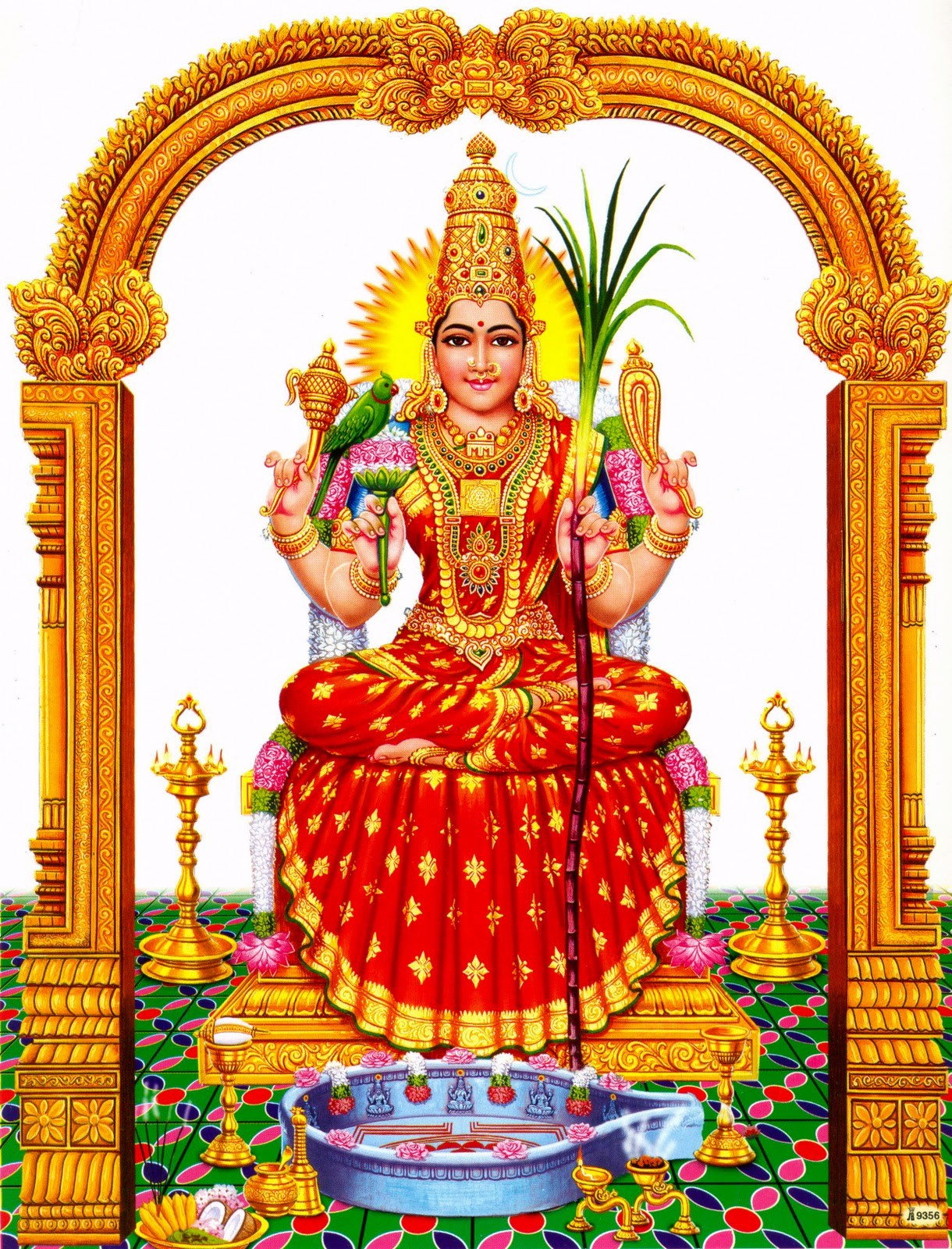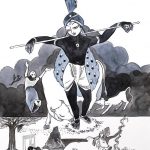Kamakshi Devi in Kanchipuram
“Ayodhya Madhura Maya Kasi Kanchi Avantika!
Puri Dwarakavathi Saiva Sapthaithate Mokshadaiyeka!”
As the poem reveals the Holy India consists of seven Mokshapuris out of which one mokshapuri is in South India named as Kanchipuram in Tamilnadu.
The town of Kanchi was once the capital of the ancient Pallavas. There is a saying that “Pushpeshu Jhati : Purusheshu Vishnu: Naarishu Ramba: Nagareshu Kanchi:” Kanchi is the most iconic city, the Kailasanathar temple as it was known as is one of the grand Pallava monuments.
The Goddess Shakthi prevails as Kamakshi Devi in Kanchipuram. Kamakshi Devi temple is one of the ancient temple and is associated with Aadi Sankaracharya. The Tamil saying Kanchi Kamakshi, Madurai Meenakshi and Kaasi Visalakshi illustrates the importance of the Shakthi shrine that it is. Kamakshi Temple is also one of the prominent Shakthi Peetham in South India. It is believed that Sati’s “Back” has fallen here after the Daksha Yagnam.
The goddess residing place in Kanchi is called as “Nabisthana Ottiyana Peetam”. “Sri Kamakshi, is derived from the heritage “Ka” means Goddess Saraswati (God of Education), “Ma” means Goddess Lakshmi (God of Wealth), “Akshi” means Eye. The name as a whole refers as the god lives in Kanchi with Goddess Saraswati and Goddess Lakshmi as her both eyes. The Lalitha Sahasranama poem is an idle example for the goddess power.
Goddess Kamakshi
The place where goddess resides in the temple is known as “Gayatri Mandapam”. The Goddess lives in temple in 3 forms. They are Sri Kamakshi, Sri Bilahasam and Sri Chakram. The goddess is in a sitting posture of “Padmasana” . The Padmasana posture is said to resemble a lotus. In the Yogic practice this resembles the form of meditation. The Goddess holds a Sugarcane bow on her left upper arm and Lotus, Parrot in her right upper arm. The Goddess also has divine chakras called Pasa and Angusa in her arms. The Goddess also has a Chandraperai (a shape of moon like structure) in her forehead. The Goddess Kamakshi is situated in the middle of temple premises.
According to the legend Kamakshi was originally a Ugra Swaroopini, and that Aadi Sankaracharya, upon establishing the Sri Chakra, personified her as the Shanta Swaroopini. It is believed that during the days of Adi Sankara, the presence of the Ugra Swaroopini was felt outside the temple precincts, and that Sankaracharya had requested her not to leave the temple complex. Symbolic of this, the festival image of Kamakshi, takes leave from Sankaracharya, at his shrine in the inner prakaram, each time she is taken out in procession.
Once the temple was visited by a dumb devotee named “Mookan”, he begged the goddess to free him from this dumbness so that he can recite the poems in praise of the goddess. The goddess blesses him and he becomes the highly i.ntellectual and starts reciting poetry on the Goddess. “Mookapanchashati” is the one the devotee wrote praising the grace of the goddess and her beauty.
Must read Navratri Special : Ashtadasa Shakthi Peetham – Chamundeswari Devi, Mysore
About the Kamakshi Temple
The temple covers an area of about 5 acres, and the sanctum is crowned with a gold plated vimanam. Kamakshi is enshrined in a seated posture in the sanctum – and is referred to as the Parabhrama Swarupini, seated with Bhrama Vishnu Rudra Eswara and Sadasiva. A Sri Chakram has been installed in front of the image and worship is offered to it.
The layout of the temple is rather complicated. The outer prakaram houses the temple tank, and several mandapams such as the 100 pillared hall, the dwajaarohana mandapam etc. Imposing views of the golden vimanam can be had from the outer prakaram, which is pierced with four entrances on all four sides. Images to Vishnu (Ninraan, Irundaan, Kidandaan) are seen near the temple tank.

One enters the four pillared hall then the inner prakaram, and climbs a series of steps, and reaches the sanctum. Immediately surrounding the sanctum are small shrines to Ardhanareeswarar, Soundaryalakshmi, Kallar (who has been mentioned in the hymns of Tirumangaialwar) and Varaahi. In this prakaram are shrines to Bangaru Kamakshi, Maha Saraswathi and Aadi Sankaracharya.
Kanchipuram is the seat of the Kanchi Kamakoti Peetham established by Adi Sankaracharya. It is believed that Sankaracharya attained samadhi at Kanchipuram, although another school of thought holds that Kedarnath in the Himalayas is the site of his samadhi.
Must read Navratri Speciaal : Ashtadasa Shakthi Peetham – Manikyamba Devi, Draksharamam
Legend of Kamakshi Devi in Kanchipuram
Legend has it that Goddess Kamakshi worshipped Shiva under a mango tree with a Shiva lingam made of sand to marry the great Lord Shiva. After a long duration of dedicated and devoted meditation to Lord Shiva, Lord Shiva appeared before her and married the Goddess Kamakshi, a divine form of Parvati. There are no traditional Parvati or Shakti shrines in the city of Kanchipuram, apart from this temple, which adds even more legend to this temple.
According to another local legend the Goddess Mahalakshmi was given curse by the Lord Vishnu to incarnate as Aarupam form. The Goddess Mahalakshmi comes to Kanchipuram and performs the worship chanting in the name of Lord Vishnu to free her from this Aarupam. After long prayers, the Goddess is freed from her Aarupam and given a Rupam by the Lord Vishnu. There exists a belief that Goddess kamakshi kumkum has to be offered to the idol of Aarupa Lakshmi within the sanctorum where by the goddess Lakshmi will fulfil your needs on the prayer.
Kanchi is also called as Satyavrita Kshetra . The Goddess worshipped Lord Siva by creating a mud idol in Kanchi. At that moment, Lord Siva incarnated as Kamba River with high tides to test the worship of the goddess, the goddess grasped the idol closely with her two hands from eroding in the tides. This prevented the idol from getting eroded in the floods. The goddess also performed Pooja by sitting in a needle tip surrounded by “Panchakagni” (surrounded by 5 fires) to free herself from the interest of livelihood. The Lord Shiva became happy, gestured before her and married the goddess. Though there are many Shiva temples in the city, the only temple to have the sanctorum of the goddess is ‘SRI KAMAKSHI AMMAN TEMPLE’. There are also eight other Shakti goddesses surrounding the temple.
 History of Kamakshi Devi in Kanchipuram
History of Kamakshi Devi in Kanchipuram
The temple sanctorum consists of a deity “Adivaraha Perumal” which is one of the 108 Vaishnaivaite deity worship temple.
The history reveals us that King Dasaratha performed “Putra Kameshi Yagam” in the temple for the Birth of a child to his kingdom. The King performed pooja to the “Nabisthanam” of the goddess in the temple. The King Dasaratha within a few months received a child. The King Dasasratha belongs to the “Ekshuvagu Vamsam” where by the prime deity is Goddess Kamakshi. The extract of this story is visible in “Markendeya Puranam”. The faith is if prayed truly the goddess provides child for the childless couples.
The Saint Adisankara born at Kaladi in Kerala travelled across all the parts of the country. When he visited Kanchipuram he felt the goddess is in a ferocious mode that the entire sanctorum was very hot. So to personify her and accomplish to her to normal state the saint sung songs in the praise of goddess named “Soundarya Lahari” then he established a Sri Chakra in front of her idol to keep her cool and personified. This srichakram is visible to all of us and all the poojas are done to srichakram too. The Saint established Sri Kanchi Kamakoti Peetam and attained Sarvagyna peetam in this holy city.
 Other Temples
Other Temples
Ekambreswarar temple, the Kamakshiamman Temple and the Kumara Kottam temple and the Ulagalanda Perumaal Temple are the primary shrines in Periya Kanchipuram. The first three mentioned above are located in a manner as to suggest the Somaskanda manifestation of Shiva, Uma and Skanda in the town of Kanchi. There are no shrines to Ambal, in any of the shrines to Shiva in Kanchi. Kamakshi is considered to be wholly present in Kanchipuram, as the only Ambal shrine.
Must read Navratri Special : Ashtadsa Shakthi Peetham – Shankari Devi, Tincomalee
[video_ads]
[video_ads2]









